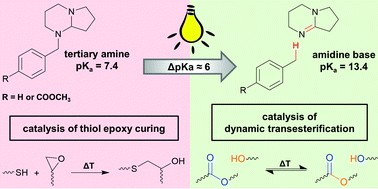Streamlined concept towards spatially resolved photoactivation of dynamic transesterification in vitrimeric polymers by applying thermally stable photolatent bases†
Abstract
Through a well-targeted design, vitrimers are able to reorganise their three-dimensional covalently crosslinked network structure by associative exchange reactions when the so-called topology freezing transition temperature (Tv) is exceeded. Although in the past decade a vast number of vitrimers have been developed, there is only a very limited number of elaborate strategies for enabling a controlled and spatially resolved onset of the exchange reactions above Tv. Herein, we describe a convenient approach for a locally controllable photoactivation of vitrimeric properties in a covalently crosslinked thiol–epoxy network by the UV-mediated release of a strong amidine base acting as an efficient transesterification catalyst. In contrast to previous work, the applied photolatent catalysts benefit from superior solubility properties, adequate curing characteristics in the non-activated state (the addition of a supplementary catalyst is not required) and an excellent thermal stability. The spatially controlled activation of vitrimeric properties in terms of dynamic transesterification, macroscopically visible as a viscoelastic flow, is demonstrated by stress relaxation studies and a reshaping experiment. Moreover, we confirm that an undesired purely thermally induced catalyst release can be entirely excluded.

- This article is part of the themed collection: Photopolymer science


 Please wait while we load your content...
Please wait while we load your content...